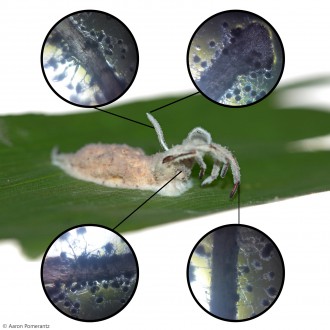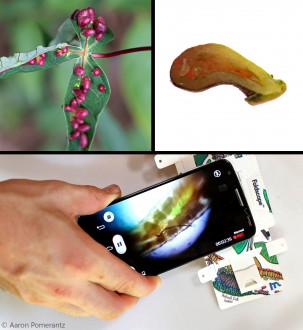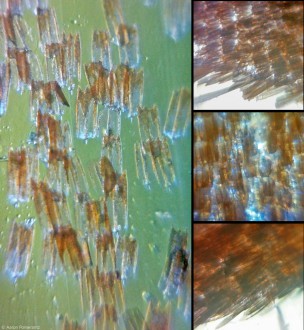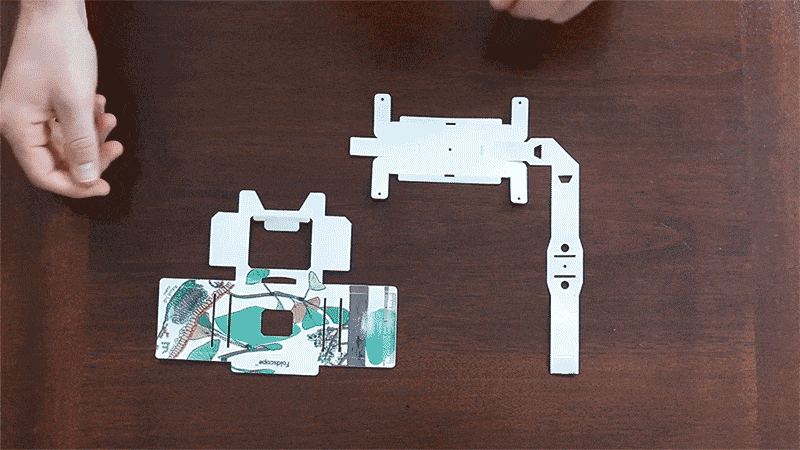- Researchers have developed a low-cost, origami-inspired microscope called the Foldscope.
- The device costs just pennies to produce and can provide up to 2,000x magnification.
- Scientists and educators are beta-testing the Foldscope in the field and in classrooms around the world.
What costs pennies, fits in your pocket, and can illuminate a world invisible to the naked eye?
The Foldscope, an “ultra-low-cost origami-based” portable microscope, is the brainchild of a group of engineers from Stanford University. The scope starts as a piece of die-cut plastic-coated paper with a small lens printed onto the sheet. By following patterns on the paper, users can fold the sheet to assemble a featherweight, hand-held microscope. A small LED light and battery mounted to the microscope illuminate slides, and users can focus the image by flexing the microscope with their thumbs. When purchased in a production run of 10,000 scopes, the materials for a single Foldscope cost less than $1.
Manu Prakash, assistant professor of bioengineering at Stanford and head of the Foldscope project, wanted to design a low-cost microscope that could be used in science education, to diagnose diseases far from medical centers, and for field research in remote and challenging environments. He’s part of a movement advocating “frugal science.” In an era of expensive equipment and huge research projects, frugal-science advocates hope to democratize science and make inquiry easier across the globe by creating low-cost laboratory tools.
In some ways, frugal science hearkens back to the foundational research of past eras: “Today people look at these extraordinary labs and forget that in the 1800s they could still do the exact same science,” Prakash told The New York Times.

Foldscope in the Amazon
Aaron Pomerantz, a field biologist at the Tambopata Research Center in southeastern Peru, is interested in novel arthropod life histories and potential new species descriptions. The research center had a microscope at one point, but humidity and routine wear-and-tear eventually got the best of the machine. Fungi growing on the microscope’s glass eventually delivered the final coupe de grâce, Pomerantz wrote in an email. While searching for an alternative, Pomerantz discovered the Foldscope. He wrote to the creators, and they mailed him a few Foldscopes to test out in the Peruvian Amazon.
In the punishing rainforest environment, Pomerantz found the Foldscope to be a surprisingly durable tool. “…it can get wet, crumpled up, muddy, etc. and still function,” he wrote. “As long as your little micro-lens isn’t damaged, it isn’t too hard to slip in a slide of your material and view it.”
With a smartphone, Foldscope users can also take pictures and short videos of their slides. And by shining a light through the Foldscope’s slide in a darkened room, the microscope can transform into a projector, displaying an image against the wall.
The tool does have limitations, of course: “The Foldscope is truly an amazing device but it won’t replace conventional microscopes,” Pomerantz wrote.
The microscope “has a pretty small focus range,” so “it can sometimes be tough to get really sharp images compared to a conventional high powered microscope.”

But an inexpensive, practically disposable, portable microscope could be a valuable addition to a field researcher’s toolbox.
“If you’re a field biologist in the Amazon rainforest looking at tiny samples like insects, mites, plant cells, or nematodes then this can be very helpful without having to preserve specimens and wait until you can get them back to a lab,” Pomerantz wrote.
Pomerantz, who studied mites for his master’s degree research, hopes to use a Foldscope in the field to document the mite diversity within the Tambopata National Reserve. The tiny arachnids are “overlooked in biodiversity surveys in the neotropics because they are so small and taxonomically challenging,” Pomerantz wrote.
Although the majority of mite species remain undescribed, tools such as the Foldscope could help bring unidentified species to light.

Democratizing science
There are a few alternatives to the Foldscope beside conventional microscopes. For example, the CellScope group at UC Berkeley is developing technology that adapts the cameras of “smart” devices (such as phones and tablets) by mounting them on mobile lenses and light sources. The CellScope technology — more durable and more expensive than the Foldscope — could be used to gather images for research and education.
Meanwhile, the Prakash lab at Stanford is currently gearing up for a third phase of Foldscope production and distribution. Those interested in hearing about the next round can sign up for updates on the Foldscope website. In the interim, you can peruse the images and stories that Pomerantz and other Foldscope users have posted here.
For citizens and scientists interested in the Foldscope, Pomerantz has a few words of advice: “Get out in the field and play!” he wrote. “I honestly have a different perspective in the field when I have a microscope that can connect to a cell phone in my pocket – I can look at things that were once invisible to me even with a macro camera lens.”
Have you used a Foldscope? How would it be useful in conservation? Tell us your thoughts in the Wildtech Forum.
Citations:
Cybulski JS, Clements J, Prakash M (2014) Foldscope: Origami-Based Paper Microscope. PLoS ONE 9(6): e98781. doi:10.1371/journal.pone.0098781

